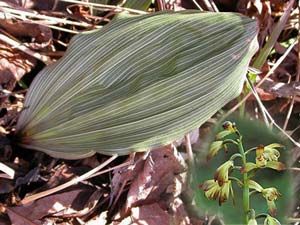
By Dan Zarlenga,
Missouri Department of Conservation
Photo caption: The leaf of the putty plant grows through winter, while its flowers (inset) bloom on a more conventional schedule in the spring.
Photo courtesy of the Missouri Department of Conservation
Green leaves growing in the middle of January? Impossible, right? Not so in the unusual world of nature. Take a hike this winter through the wooded slopes of rich bottomlands, or perhaps along a stream, or explore the bottom of a ravine. Turn your gaze downward and you might just see a peculiar green leaf growing from the forest floor. And yes, right in the middle of winter even!
This elliptical leaf displays a striking green-and-white-striped pattern that really stands out among the other brown and lifeless leaves on the forest floor. You’ve just seen the putty root plant, also known as the Adam and Eve orchid.
Missouri is home to about 35 species of orchids, yet only two of them cultivate their leaves in winter. The Adam and Eve orchid is one. It’s almost as if it didn’t get the memo that leaves are supposed to grow in spring!
Each putty root plant only has one or two leaves, which emerge in September—just as most other plant and tree leaves are gearing up to drop away. The putty plant leaves stay green all through winter. Being out of synch with the rest of its flora fellows does provide an advantage though. With the tree canopy completely open above, putty root plants have to themselves all the meager sunlight winter offers. This strategy allows them to “avoid the crowds” of other growing things and use the magic of photosynthesis to take on energy for the growing season to come, without competition.
It’s probably easy to guess that these leaves begin to wither around May when leaves of almost every other plant are emerging. May and June are also the months when the flowers of putty root bloom. At least they are in synch that way with the rest of nature. The half-inch flowers are not very showy, a group of 7 to 15 growing on a stem. They are light to dark brown, sometimes with purplish tinting toward the bases of their three sepals and petals. Their white lips are small and three-lobed, with magenta markings. Biologists believe that sweat bees are likely the insects responsible for pollinating the putty root.
A lot of plants have unusual names—but also unlike the rest, this plant has two of them! It gets the moniker of “putty plant” because it has rounded underground stems, called corms, that contain a glutinous ingredient that settlers used historically as a glue to mend broken pottery. It’s because these corms a usually formed in pairs that the plant is also called the “Adam and Eve” orchid.
Whichever name you choose to use, no one can deny this is an unusual member in the kingdom of flora. The putty plant uses a unique trick to outwit the rest of the growing world, flying under winter’s radar to land an enormous advantage for survival.
For more information visit www.mdc.mo.gov.


